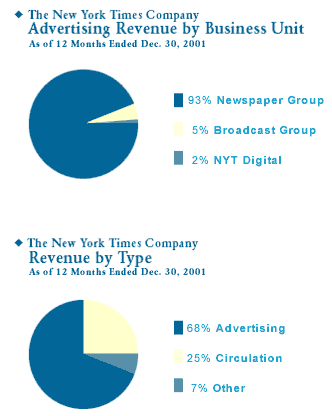International Business Reporting Class at SIPA
April 18, 2002
Will Online Ventures Fuel New Profits at the New York Times?
By Kosuke Takahashi
So far no media play--not even the giants such as AOL Time Warner Inc.-- has figured out how to avoid the sharp twists and turns of the Net economy. The New York Times Company, though, is trying hard to shove its Internet business into the black in a bid to make up for scarce ad dollars. Can they do it? Early signs are promising.
 The Timesf Internet
business unit, New York Times Digital (NYTD), includes both NYTimes.com, which has been the No. 1 newspaper site for 23 months in
a row, and
Boston.com, the No.1 regional Web
site in the country, respectively, in terms of
total monthly page views, as measured by Jupiter Media Metrix.
The Timesf Internet
business unit, New York Times Digital (NYTD), includes both NYTimes.com, which has been the No. 1 newspaper site for 23 months in
a row, and
Boston.com, the No.1 regional Web
site in the country, respectively, in terms of
total monthly page views, as measured by Jupiter Media Metrix.
However, NYTD accounts for just 2 percent of 2001 revenues for the Company and is still money losing. But management thinks it could become a significant contributor to the top and bottom lines over time. gClearly, our model is one that draws profitability from a diversity of online revenue streams and seeks to contribute maximum value to the core,h said Martin Nisenholtz, CEO of NYTD, at the Jupiter Media Forum 2002 last month.
Without a doubt, NYTD has been very active in launching new ventures. October 2001 it started an electronic edition of the flagship newspaper, The New York Times. A month later it also opened gSurround Sessions,h an innovative type of advertising that allows a single advertiser to control every major ad position across multiple pages of the Web site. This January it combined its print and online recruitment services into an integrated offering called Job Market.
Until 2000 the New York Times Co. did not have to consider such new businesses, for the Times had enjoyed steady earnings growth. As the whole corporate America rode on the upswing of the advertising market, the diluted earnings per share had grown an average of more than 15 percent per year since 1994. In 2000 the publisher could show off a record $2.10 per diluted share, excluding special items.
But last year the crunch came to the Times amid the worst advertising slump in years. Diluted earnings per share decreased 24.3 percent to $1.59 from 2000. Total revenues also declined 10.6 percent to $ 3.0 billion. This was primarily due to declining dot.com and technology advertising, rising newsprint prices, and a slowing U.S. economy.
gIn 2001, in the United States, advertising had the largest year-over-year decline since 1938,hsaid Catherine J. Mathis, vice president of corporate communications. gThis is the industry wide statistic. Certainly we were not alone in this.h As one measure to cope with the difficult advertising environment, just like many media companies did, the Times cut more than 70 employees at NYTD, or 17 percent of its work force last year.
But the Times is still holding lots of lingering hope for NYTD in adverse circumstances. Most recently, NYTD announced that the NYTimes.com Web site will incorporate links to the BBC's global news programs. gNY Times.com has been successful,h said Jason L. Rapp, Manager of Corporate Planning at the Times. He notes that for 2001, NYTD first achieved positive cash flow from operations (EBITDA) of $0.8 million a year ahead of schedule, compared with loss of $36.3 million for 2000.
As an example of the strength of NYTimes.com, Nisenholtz also pointed out at the Forum that last year NYTimes.com generated 85,000 New York Times print subscriptions and Boston.com brought in 10,000 Boston Globe subscriptions.
According to Media Metrix, the NYTD consolidation was ranked the 45th most-visited property on the Web for February, up from the ranking of 52 for January. And the NYTimes.com is the only Top Four news and information site with a 100 percent registered user base.
Currently, the price/earnings ratio of the Times is much lower than its major rivals such as Dow Jones & Co. and Gannett Co. While the ratio of the Times is 17, those of Dow Jones and Gannett are 49 and 24, respectively. This suggests that the Timesf stock is gcheaph or gundervalued.h
gIf the economy will recover in the second half of this year, 2002 EPS will grow in the mid-single digits to low-double digits,h Mathis said. gEven if the economy will not recover in the second half of this year, 2002 EPS will still grow modestly.h
If her forecast is correct, the Timesf stock could soar more than other newspaper stocks, receiving the benefits of the leading positions of their Web sites and net ventures over time. Investors should consider buying Times shares for both their short- and long-term portfolios.